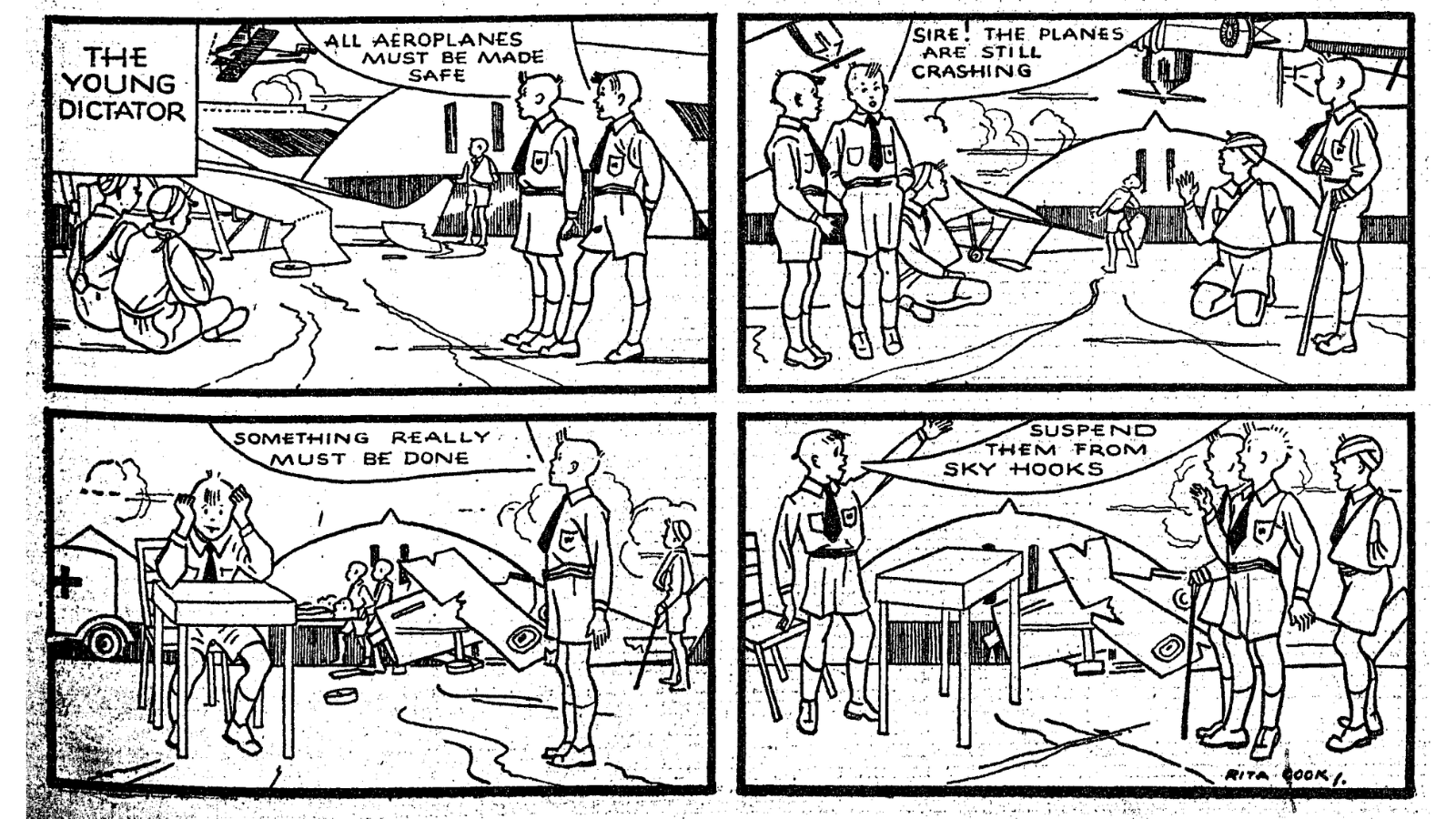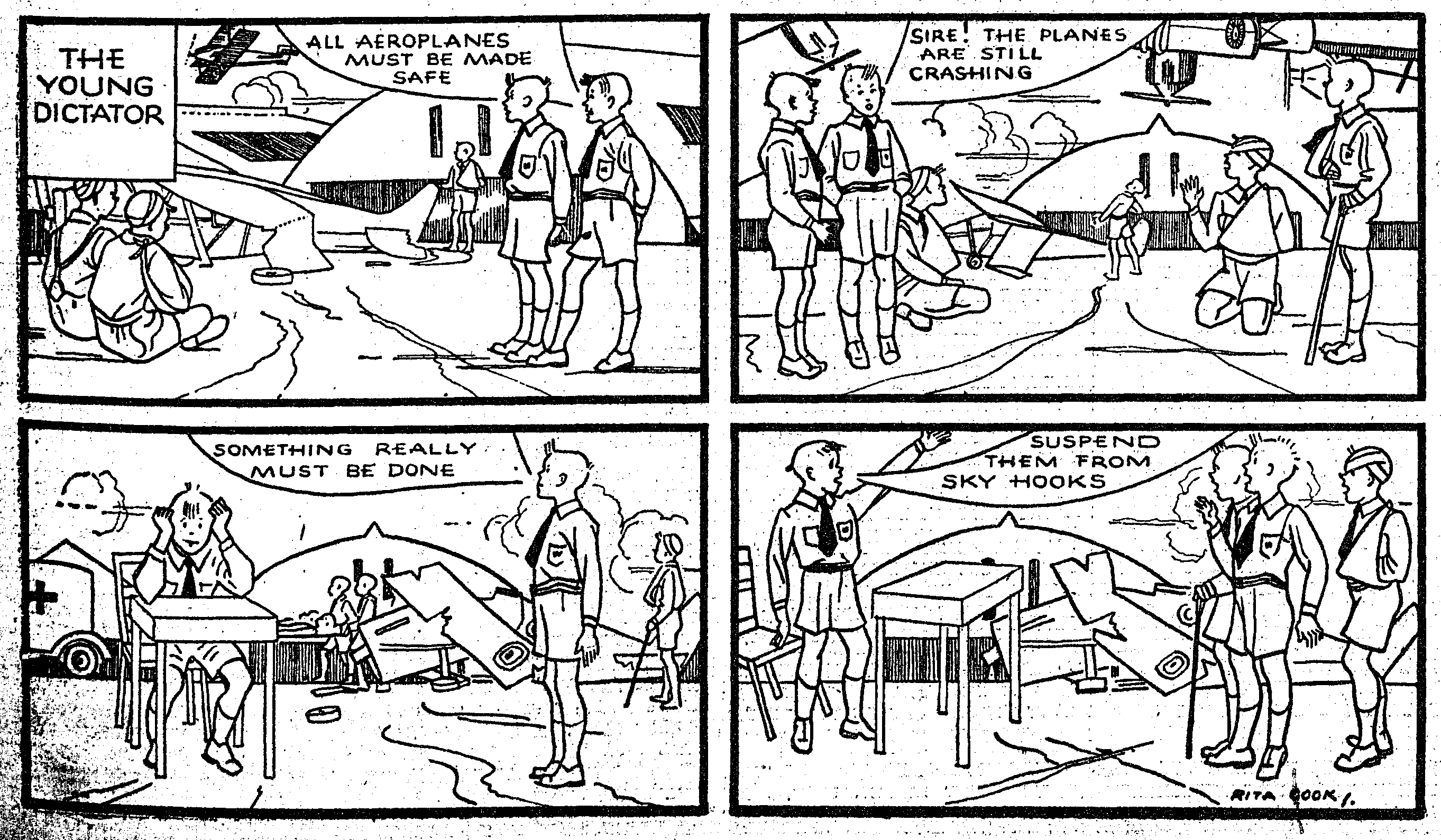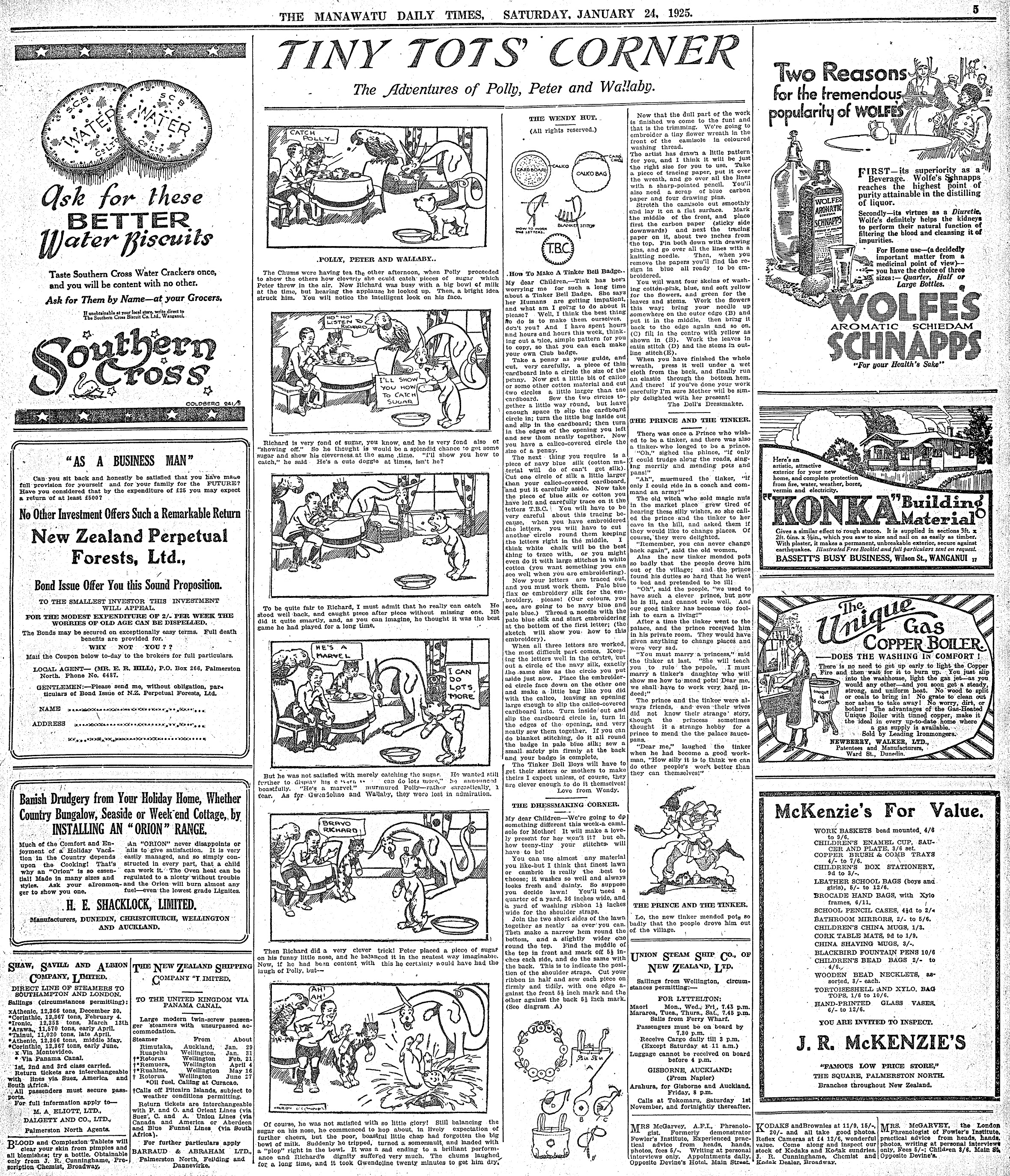Hannah Benbow is the comics and cartoons librarian at the Alexander Turnbull Library in Wellington – and she draws on that expertise in this essay looking into the early days of comics in the ‘children’s pages’ of Aotearoa newspapers of the first half of the twentieth century.

The beginning of locally produced comics for children in Aotearoa can be traced to the 1920s, when children’s pages became a mainstay of New Zealand newspapers. Comic books were just around the corner, but for a brief period, newspaper strips dominated. Initially, papers ran syndicated imported comics, but it wasn’t long before we were producing our own, and comics with titles like ‘Ngaio and her magic paddle‘ and ‘The Kowhai Fairies and the pumpkin‘ appeared in newspapers around the country. A few of their creators went on to have high profile careers – Avis Acres, John McNamara and Rita Angus all created comics for children early in their careers – but mostly the artists and their work are forgotten, calling back to a time beyond living memory or childhood nostalgia.
Avis Acres, John McNamara and Rita Angus all created comics for children early in their careers
Should they stay that way? There’s admittedly much to criticise and cringe at in the newspaper comic strips published in the 1920s and 1930s. At their worst they’re both racist and banal: western fairies wearing piupiu, their stories told in insipid rhyming couplets. There is a twee and educational focus that bears little resemblance to the adventure and hero-filled comic books that were about to burst onto the scene.
And yet, among the many forgettable or problematic comics, there are hidden gems to uncover. The comics that have stood the test of time are smart, satirical, and thoughtfully designed. They also shed light on creative lives and careers in the inter-war period, especially for women. Rita Angus produced at least three series of comics for The Press between 1935 and 1936, and in my mind, her work represents the best of the format during this time.
The comics that have stood the test of time are smart, satirical, and thoughtfully designed.
The first and best known of Angus’ comics is ‘Peter and Paul Penguin in Polar Land‘. Whimsical and beautiful, Adrian Kinnaird describes the comics as having ‘careful consideration of design elements in sequential storytelling was a revolutionary approach that only a few cartoonists at the time were starting to pick up on’ (From Earth’s End, p.14). Angus’ ‘The Young Dictator’, about a group of children playing at war, ran from November 1935 to April 1936 . Angus was a committed pacifist watching the rise of fascism throughout the world; the politics simmering just beneath the surface of Angus’ work is hard to miss. .

Angus was not the only artist producing comics as part of a wider artistic career. Children’s comics from this period offer insights into the world of working artists and bring to light the names of artists whose work might otherwise be forgotten. Jocelyn Harrison-Smith produced comics for the Auckland Star between 1927 and 1929 while at Elam. In the 1943 issue of Art in New Zealand, she described herself as a ‘Commercial artist. (Alas!)’, but she was also an accomplished landscape painter and exhibited widely. In 1965 she won the Crown Lynn design award. D. Price, a somewhat elusive artist whose work appeared in the Auckland Star from 1926, was also producing illustrations and poetry for the paper.
Children’s comics from this period offer insights into the world of working artists and bring to light the names of artists whose work might otherwise be forgotten.
Few of the creators from this period went on to have a career in comics as we would now understand it, but there are some notable exceptions. Avis Acres published her first comics in the Auckland Star in 1929. ‘The adventures of Twink and Wink the Star Babies’ tells the surreal story of Twink and Wink who catch a ride on a benevolent cloud to meet the Man in the Moon, only to find themselves transported to Earth to dine with Kingfish and his followers on the sea floor. Acres returned to comics twenty years later, publishing the ‘Hutu and Kawa’ series for a decade in the New Zealand Herald. John McNamara produced caricatures, cartoons and children’s comics in New Zealand from the mid 1930s, and continued his work in comics after moving to the United Kingdom in 1951.

It’s interesting to consider where the creators saw these comics fitting into the wider canon. Many of the strips feel like they relate more closely to children’s picture books than to the emerging comic book format. The action is generally slow-paced; they’re sometimes funny, but often not. Long, rhyming captions are the primary way text is incorporated, rather than the speech bubbles today’s comic readers would expect to see.
Long, rhyming captions are the primary way text is incorporated, rather than the speech bubbles today’s comic readers would expect to see.
Even compared to the syndicated comics in other parts of the children’s pages, there’s a naivety and politeness to many of the comics produced in New Zealand – and Australasia more broadly. The Manawatu Daily Times ran an Australian comic, ‘The adventures of Polly, Peter and Wallaby’, top-to-bottom rather than crossways. Their inoffensive and educational content was much more palatable to parents and educators than what they read in the comic books that would arrive en masse in the 1930s.

While children’s pages published content for children during this time, they also encouraged contributions from their audiences, with readers submitting letters, stories, poems, games, jokes, illustrations – and comics! Many also offered membership and ongoing correspondence between readers and the benevolent, usually female, editor of the children’s page. A significant number of the comics from the 1920s and 1930s need to be understood in this context, written by young people and submitted for feedback as well as publication.
Many [children’s pages] also offered membership and ongoing correspondence between readers and the benevolent, usually female, editor of the children’s page.
Margaret Parker (then Margaret Wigley) began publishing comics in the Press in 1938 (she was 21), but she had been contributing to the children’s pages of the Timaru Herald for at least a decade prior to this. Other artists were also young when they submitted comics to the children’s pages: Avis Acres was nineteen when the Star Babies were first published; Jocelyn Harrison-Smith and John McNamara were both seventeen. These were safe and accepting spaces in which to dip your toes into publishing and experiment with formats and artistic styles.

All of this is also a context for a conversation about gender. Spaces for women within the production and consumption of comics are still contested in 2020, so it’s noteworthy that most of these comics were produced by women, almost a century ago. It’s tempting to see this period as an early heyday, especially with figureheads as talented, successful and cherished as Angus and Acres. But children’s pages were heavily gendered spaces, occupied and managed largely by women in their roles as mothers and educators. The content on these pages was largely innocent and educational, and as the comic genre evolved more towards action and adventure, the opportunities for women diminished.
Spaces for women within the production and consumption of comics are still contested in 2020, so it’s noteworthy that most of these comics were produced by women, almost a century ago.
There is still a lot that can be learnt about these comics: about how they were read and received, about the evolution of children’s pages and their content, and especially about the artists who created them. Often they married, changed their names and became harder to trace. Perhaps art became a private passion rather than a public profession for some, or they had careers in illustration and commercial art, as Jocelyn Harrison-Smith did, their work becoming as ubiquitous as it is anonymous.
Newspaper comics for children from the 1920s and 1930s reward a contemporary re-reading. They offer a window onto an interesting time in the artform’s development and in artistic practice. Many comics from this period are available to read on PapersPast. If you’re interested in reading more, here are some highlights.
Avis Acres: ‘Twink and Wink the Star Babies’1, 2, 3, 4, 5, 6, 7, 8, 9, 10, 11, 12, 13
Rita Angus, ‘Peter and Paul Penguin in Polarland’1, 2, 3, 4, 5, 6, 7, 8
D. Price ‘The Kowhai Fairies and the Pumpkin’.
Hannah Benbow
Hannah is the cartoon and comics librarian at the Alexander Turnbull Library, meaning she works with artists to help collect, preserve and promote New Zealand’s cartooning heritage. She has an MA in New Zealand history as well as a Library degree, and has been working in the heritage sector for the last decade.



